Anthropometric Analysis of Selected Body Dimensions and Comparison with the Design Approach for Forestry and Agricultural Machine Operators
Abstract
:1. Introduction
2. Materials and Methods
2.1. Anthropometric Analysis
2.2. Statistical Analysis
3. Results
3.1. Results of Anthropometric Analysis
3.2. Analysis of Normalized Dimensions and Comparison with an Anthropometric Analysis
4. Discussion
5. Conclusions
Author Contributions
Funding
Institutional Review Board Statement
Informed Consent Statement
Data Availability Statement
Acknowledgments
Conflicts of Interest
References
- Moskalik, T.; Borz, S.A.; Dvořák, J.; Ferenčík, M.; Glushkov, S.; Muiste, P.; Lazdins, A.; Styranivsky, O. Timber harvesting methods in Eastern European countries: A review. Croat. J. For. Eng. 2017, 38, 231–241. [Google Scholar]
- Melander, L.; Ritala, R. Separating the impact of work environment and machine operation on harvester performance. Eur. J. For. Res. 2020, 139, 1029–1043. [Google Scholar] [CrossRef]
- Zewdie, R.; Kic, P. Microclimate in Drivers’ Cabin of Combine Harvesters. In Proceedings of the 6th International Conference on Trends in Agricultural Engineering 2016; Prague, Czech Republic, 7 September 2016, Choteborsky, R., Kovar, S., Krepcik, V., Herak, D., Eds.; Czech University Life Sciences Prague: Prague, Czech Republic, 2016; pp. 743–748. [Google Scholar]
- Lee, D.H.; Kim, Y.J.; Choi, C.H.; Chung, S.O.; Nam, Y.S.; So, J.H. Evaluation of operator visibility in three different cabins type Far-East combine harvesters. Int. J. Agric. Biol. Eng. 2016, 9, 33–44. [Google Scholar] [CrossRef]
- Wongwien, T.; Nanthavanij, S. Multi-objective ergonomic workforce scheduling under complex worker and task constraints. Int. J. Ind. Eng. Theory 2017, 24, 284–294. [Google Scholar]
- Fontana, G.; Seixas, F. Ergonomic evaluation of the workstation of forwarder and skidder models. Rev. Arvore 2007, 31, 71–81. [Google Scholar] [CrossRef]
- Gejdoš, M.; Vlčková, M.; Allmanová, Z.; Balážová, Ž. Trends in workplace injuries in Slovak forest enterprises. Int. J. Environ. Res. Public Health 2019, 16, 141. [Google Scholar] [CrossRef] [Green Version]
- Pinzke, S.; Svennefelt, C.A.; Lundqvist, P. Occupational injuries in Swedish agriculture: Development and preventive actions. J. Agric. Saf. Health 2018, 24, 193–211. [Google Scholar] [CrossRef]
- Kim, H.; Rasanen, K.; Chae, H.; Kim, K.; Kim, K.; Lee, K. Farm work-related injuries and risk factors in South Korean agriculture. J. Agromedicine 2016, 21, 345–352. [Google Scholar] [CrossRef] [PubMed]
- Zellner, K.; Jaeger, U.; Kromeyer Hauschild, K. Height, weight and BMI of schoolchildren in Jena, Germany—are the secular changes levelling off? Econ. Hum. Biol. 2004, 2, 281–294. [Google Scholar] [CrossRef]
- Bodenhorn, H. Height, weight and body mass index of mid-19th century New York legislative officers. Econ. Hum. Biol. 2010, 8, 291–293. [Google Scholar] [CrossRef]
- Widyanti, A.; Susanti, L.; Sutalaksana, Z.; Muslim, K. Ethnic differences in Indonesian anthropometry data: Evidence from three different largest ethnics. Int. J. Ind. Ergon. 2015, 47, 72–78. [Google Scholar] [CrossRef]
- Havari, E.; Peracchi, F. Growing up in wartime: Evidence from the era of two world wars. Econ. Hum. Biol. 2017, 25, 9–32. [Google Scholar] [CrossRef] [PubMed]
- Tanner, J.M. Growth as a measure of the nutritional and hygienic status of a population. Horm. Res. 1995, 38, 106–115. [Google Scholar] [CrossRef]
- Komlos, J.; Lauderdale, B.E. Underperformance in affluence: The remarkable relative decline in U.S. heights in the second half of 20th century. Soc. Sci. 2007, 88, 283–306. [Google Scholar] [CrossRef]
- Cole, T.J. Secular trends in growth. Proc. Nutr. Soc. 2000, 59, 317–324. [Google Scholar] [CrossRef] [PubMed] [Green Version]
- Cole, T.J. The secular trend in human physical growth: A biological view. Econ. Hum. Biol. 2003, 1, 161–168. [Google Scholar] [CrossRef]
- Chodasová, Z.; Kucharčiková, A.; Tekulová, Z. Impact Analysis of Production Factors on the Productivity Enterprise. In Proceedings of the International Scientific Conference on Knowledge for Market Use: Women in Business in the Past and Present; Olomouc, Czech Republic, 10–11 October 2015, Slavíčková, P., Tomčík, J., Eds.; Societas Scientiarum Olomucensis II.: Olomouc, Czech Republic, 2015; pp. 256–263. [Google Scholar]
- Tunay, M.; Melemez, K. An analysis of biomechanical and anthropometric parameters on classroom furniture design. Afr. J. Biotechnol. 2008, 7, 1081–1086. [Google Scholar]
- Gejdoš, M.; Hitka, M.; Potkány, M.; Balážová, Ž. Analysis of Human Resources and Anthropometric Data Relating to Forestry Machine Operators in Slovakia. In Proceedings of the Innovation Management and Education Excellence Through Vision 2020, VOLS I –XI; Milan, Italy, 25–26 April 2018, Soliman, K.S., Ed.; International Business Information Management Assoc-Ibima: Norristown, PA, USA, 2018; pp. 2256–2262. [Google Scholar]
- Alicandro, G.; Grande, E.; Sebastiani, G.; Violante, F.S.; La Vecchia, C.; Frova, L. Mortality from suicide among agricultural, fishery, forestry and hunting workers in Italy and the contribution of work-related factors. Occup. Environ. Med. 2021, 78, 117–124. [Google Scholar] [CrossRef]
- Ostlund, L.; Obom, A.; Lofdahl, A.; Rautio, A.M. Women in forestry in the early twentieth century—new opportunities for young women to work and gain their freedom in a traditional agrarian society. Scand. J. For. Res. 2020, 35, 403–416. [Google Scholar] [CrossRef]
- Aguilera, E.; Guzman, G.I.; De Molina, M.G.; Soto, D.; Infante-Amate, J. From animals to machines. The impact of mechanization on the carbon footprint of traction in Spanish agriculture: 1900-2014. J. Clean. Prod. 2019, 221, 295–305. [Google Scholar] [CrossRef]
- Pompei, D.; Rossi, R.; Vecchiola, R.; Angelone, A.M.; Fabiani, L. Accident prevention in agriculture in the ASL1 Abruzzo Local Health Service: Protection facilities for tractors. Med. Lav. 2015, 106, 261–270. [Google Scholar] [PubMed]
- Sayganov, A.S.; Lipskaya, V.K. Efficiency of combine harvesters operation in agriculture of Belarus. Proc. Natl. Acad. Sci. Belarus. Agrar. Ser. 2018, 56, 213–225. [Google Scholar] [CrossRef] [Green Version]
- Jankovský, M.; Allman, M.; Allmanová, Z.; Ferenčík, M.; Merganič, J.; Messingerová, V. Is timber haulage safe? A ten year study of occupational accidents. Saf. Sci. 2019, 113, 154–160. [Google Scholar] [CrossRef]
- Jankovský, M.; Merganič, J.; Allman, M.; Ferenčík, M.; Messingerová, V. The cumulative effects of work-related factors increase the heart rate of cabin field machine operators. Int. J. Ind. Ergon. 2018, 65, 173–178. [Google Scholar] [CrossRef]
- Vlčková, M.; Gejdoš, M.; Němec, M. Analysis of vibration in wood chipping process. Akustika 2017, 28, 106–110. [Google Scholar]
- ISO 3411. Earth-Moving Machinery—Physical Dimensions of Operators and Minimum Operator Space Envelope; ISO: Geneva, Switzerland, 2007. [Google Scholar]
- Strelka, F. Methodology for measurement of basic anthropometric parameters. Acta Hyg. Epid. Microbiol. 1978, 11, 73027. [Google Scholar]
- Baffoe-Djan, J.B.; Smith, S.A. Descriptive statistics in data analysis. In Routledge Handbook of Research Methods in Applied Linguistics, 1st ed.; McKinley, J., Rose, H., Eds.; Routledge: Oxford, UK, 2020; pp. 398–414. [Google Scholar]
- Patten, M.L.; Newhart, M. Descriptive and inferential statistics. In Understanding Research Methods: An Overview of the Essentials, 10th ed.; Patten, M.L., Newhart, M., Eds.; Routledge: Oxford, UK, 2018; pp. 203–206. [Google Scholar]
- Young, J.; Wessnitzer, J. Descriptive statistics, graphs, and visualisation. In Modern Statistical Methods for HCI, 1st ed.; Robertson, J., Kaptein, M., Eds.; Springer: Dordrecht, The Netherlands, 2016; pp. 37–56. [Google Scholar] [CrossRef]
- Šmelko, Š.; Wolf, J. Štatistické Metódy v Lesníctve [Statistical Methods in Forestry], 1st ed.; Príroda Bratislava: Bratislava, Slovakia, 1977; p. 330. [Google Scholar]
- Barroso, M.P.; Arezes, P.M.; Costa, L.G.; Miguel, A.S. Anthropometric study of Portuguese workers. Int. J. Ind. Ergon. 2005, 35, 401–410. [Google Scholar] [CrossRef]
- Bolstad, G.; Benum, B.; Rokne, A. Anthropometry of Norwegian light industry and office workers. Appl. Ergon. 2001, 32, 239–246. [Google Scholar] [CrossRef]
- Chuan, T.K.; Hartono, M.; Kumar, N. Anthropometry of the Singaporean and Indonesian populations. Int. J. Ind. Ergon. 2010, 40, 757–766. [Google Scholar] [CrossRef] [Green Version]
- Lipoldová, M.; Hitka, M.; Sedmák, R.; Kolena, B.; Jambal, T. Secular trends of adult population and their impacts in industrial design and ergonomics. Appl. Sci. 2020, 10, 7565. [Google Scholar] [CrossRef]
- Gejdoš, M.; Lipoldová, M. Drivers Workplace of Transport Vehicles in Relation to Anthropometric Dimensions of Adult Population in Slovakia. In Proceedings of the International Scientific Conference on LOGI—Horizons of Autonomous Mobility in Europe, Transportation Research Proceedia, České Budějovice; Czech Republic, 14–15 November 2019, Stopková, M., Bartuška, L., Stopka, O., Eds.; Elsevier Science Bv: Amsterdam, The Netherlands, 2019; pp. 321–326. [Google Scholar] [CrossRef]
- Hitka, M.; Gejdoš, M.; Sedmák, R.; Balážová, Ž. Workplace environment of earth-moving machine operators in terms of anthropometric data development in the Slovak republic. Work 2020, 65, 799–808. [Google Scholar] [CrossRef]
- Brkic, A.; Veljkovic, Z.; Brkic, V.S.; Essdai, A.; Pavicevic, S. Differences in Serbian and Libyan crane operators’ anthropometric measurements and cabin interior space modeling. Work 2021, 68, 197–212. [Google Scholar] [CrossRef]
- Ghaderi, E.; Maleki, A.; Dianat, I. Design of combine harvester seat based on anthropometric data of Iranian operators. Int. J. Ind. Ergon. 2010, 44, 810–816. [Google Scholar] [CrossRef]
- Melemez, K.; Tunay, M. Anthropometric dimensions of Turkish operators of loading tractors used in forestry and the design of the workplace. Ama-Agr. Mech. Asia Af. 2011, 42, 70–78. [Google Scholar]
- Hsiao, H.; Whitestone, J.; Bradtmiller, B.; Whisler, R.; Zwiener, J.; Lafferty, C.; Kau, T.Y.; Gross, M. Anthropometric criteria for the design of tractor cabs and protection frames. Ergonomics 2005, 48, 323–353. [Google Scholar] [CrossRef] [PubMed]
- Chandra, M.P.; Sharma, S.C. Anthropometric analysis of selected body dimensions of farm workers for design of agricultural implements—An approach. Ama-Agr. Mech. Asia Af. 2012, 43, 64–68. [Google Scholar]
- Metha, C.R.; Gite, L.P.; Pharade, S.C.; Majumder, J.; Pandey, M.M. Review of anthropometric considerations for tractor seat design. Int. J. Ind. Ergon. 2008, 38, 546–554. [Google Scholar] [CrossRef]
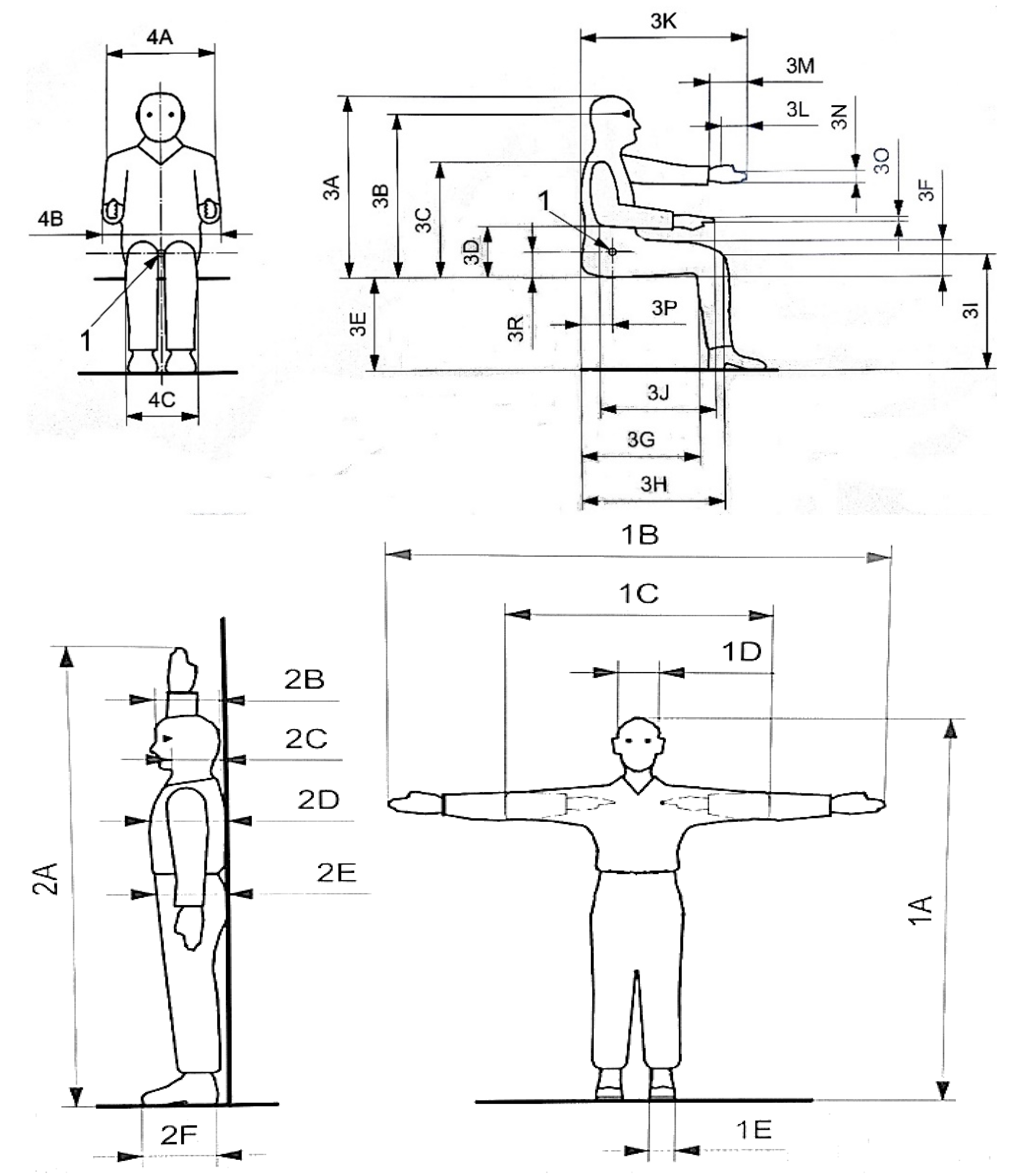
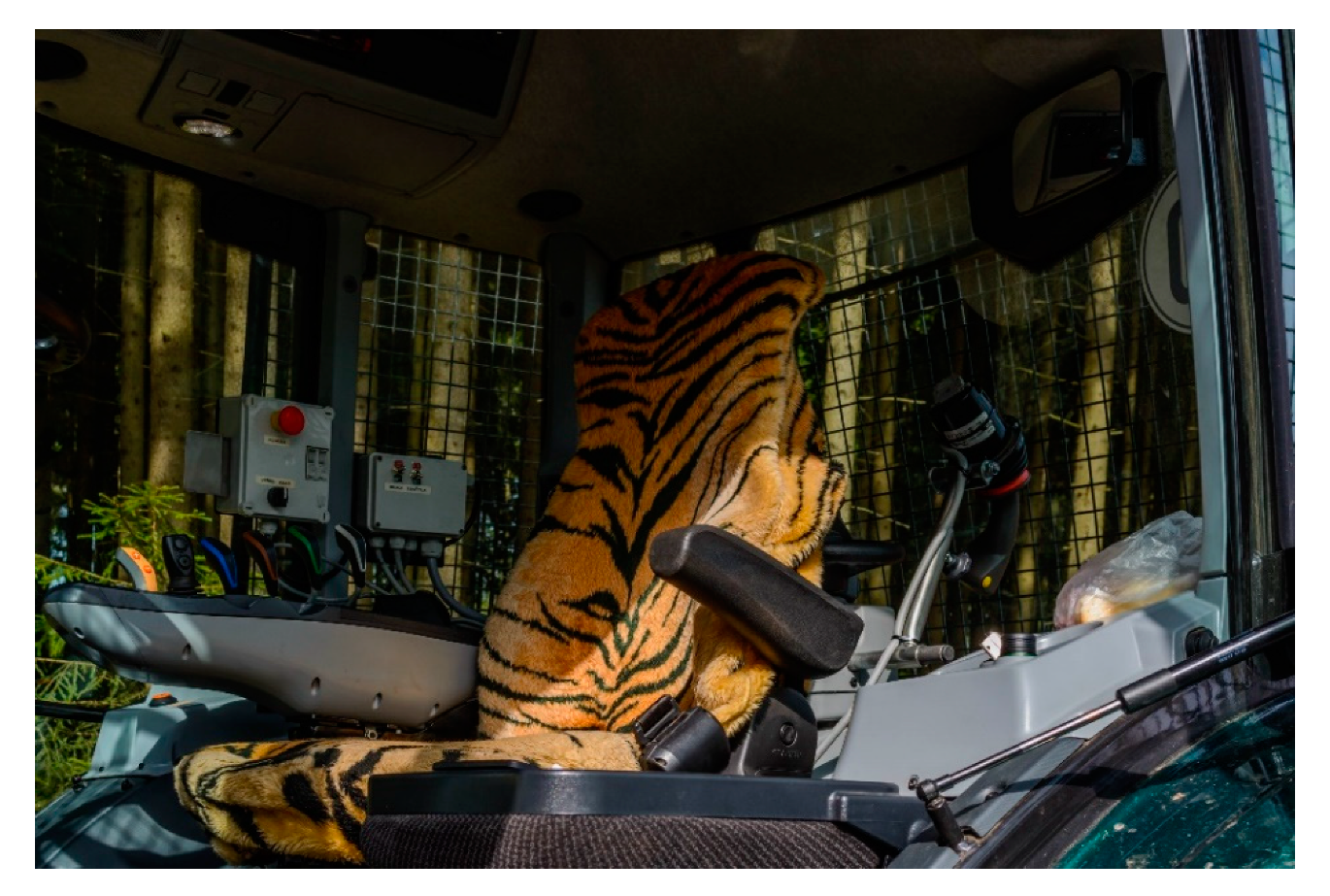
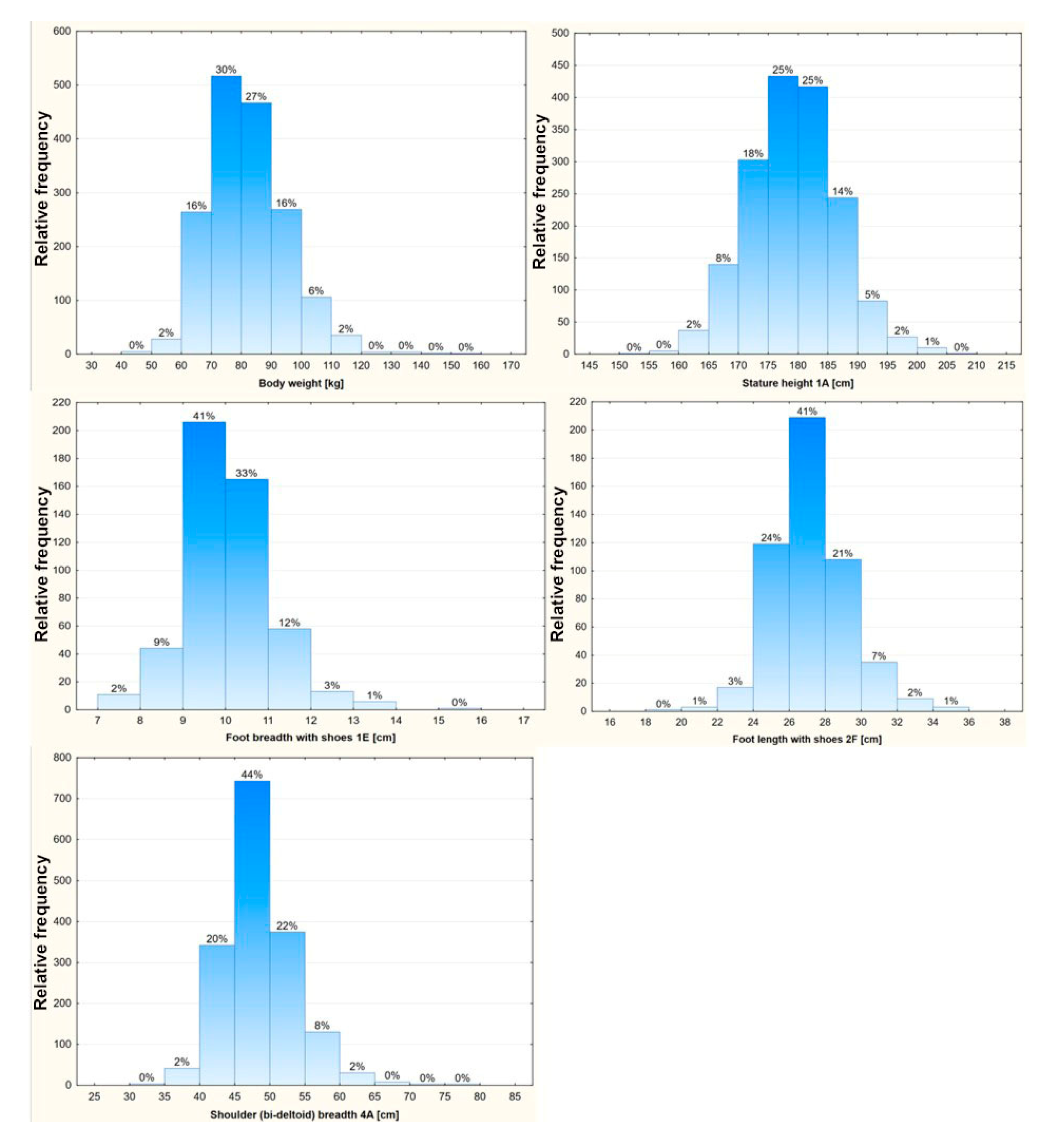
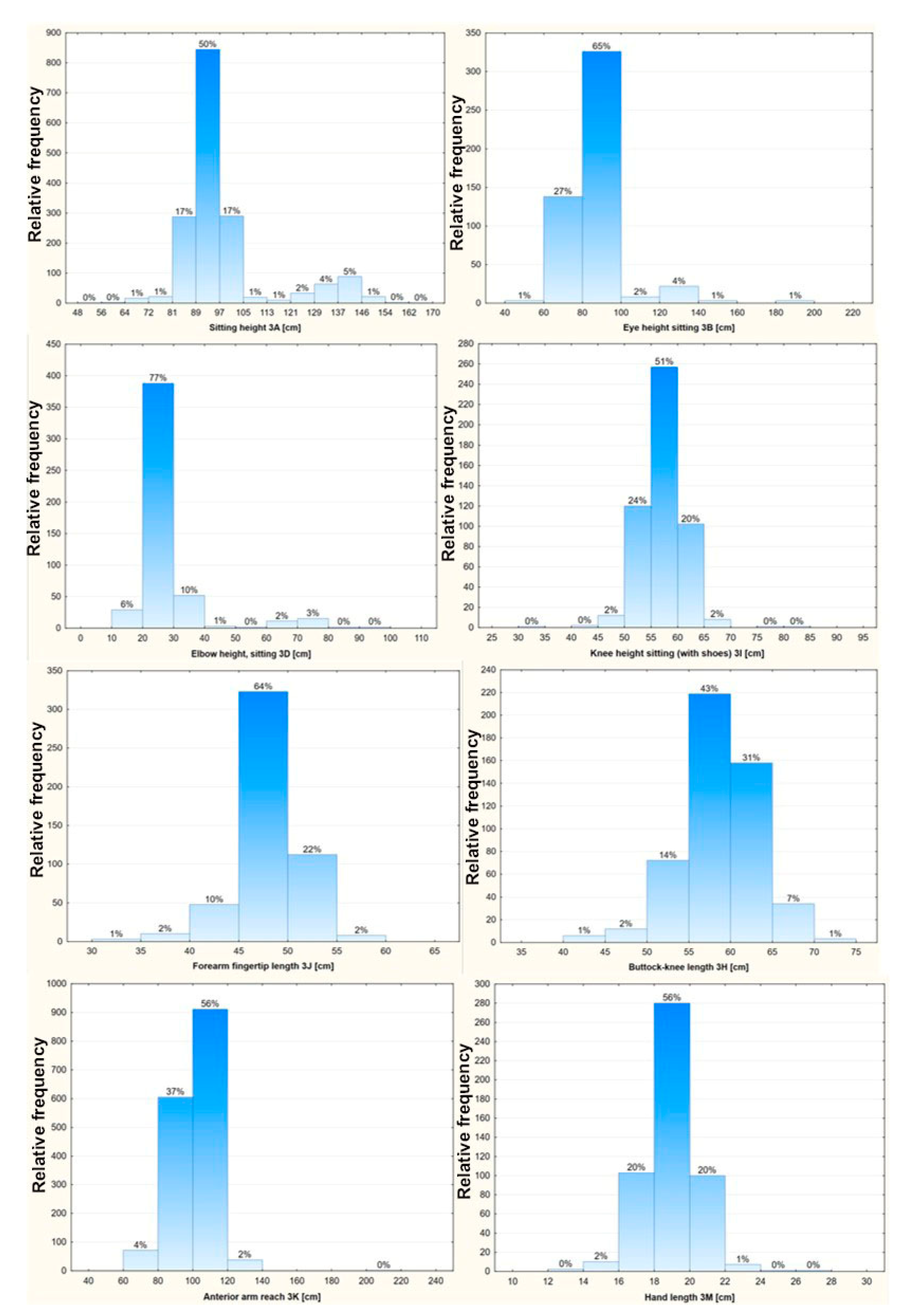
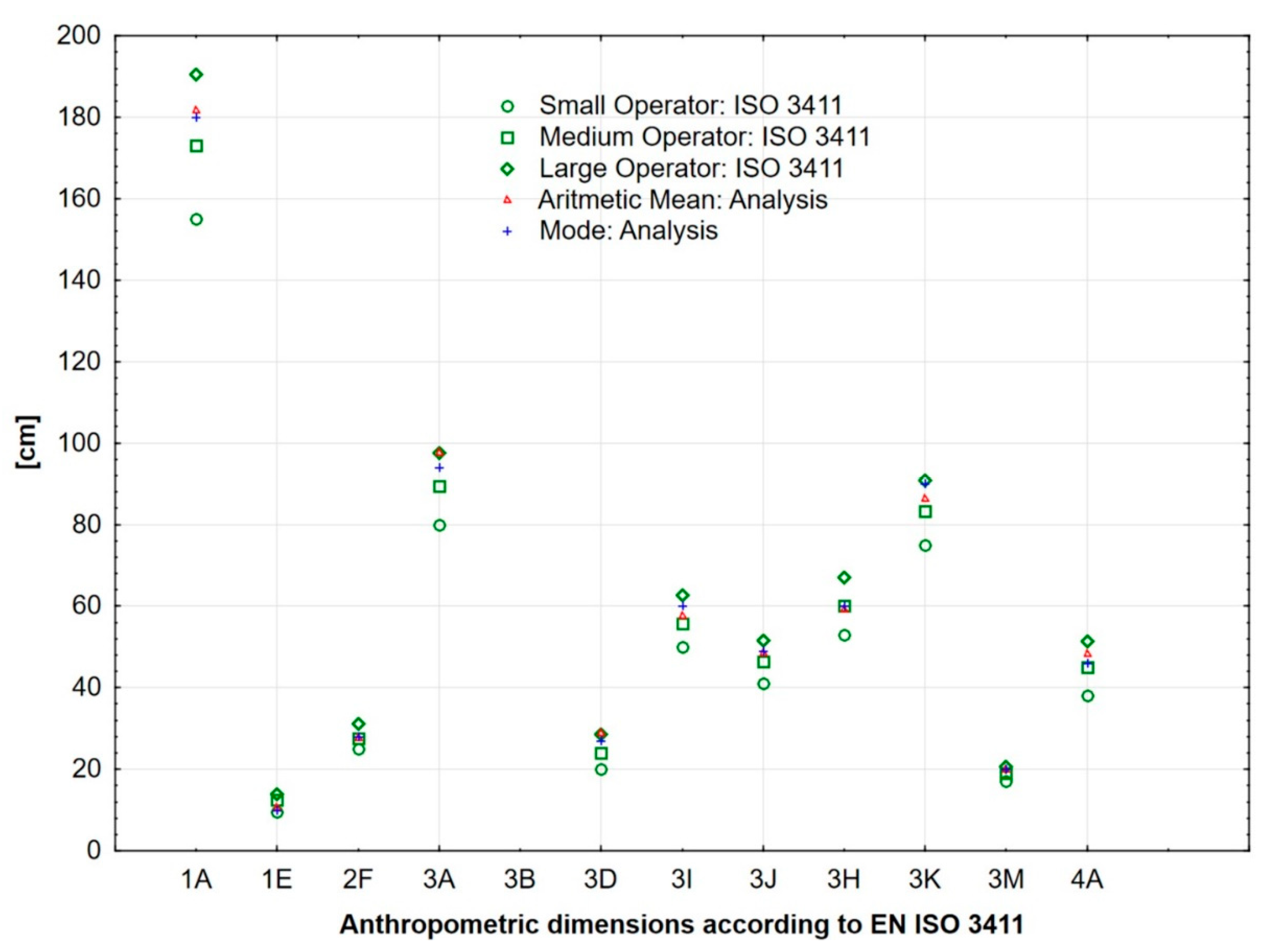
| Dimension | Arithmetic Mean | Median | Mode | Minimum | Maximum | Variance | Std. Deviation | Std. Error |
|---|---|---|---|---|---|---|---|---|
| Body weight (kg) | 83.0 | 82.0 | 80.0 | 49.0 | 151.0 | 178.12 | 13.35 | 0.323 |
| 1A (cm) | 180.0 | 180.0 | 180.0 | 155.0 | 208.0 | 54.32 | 7.37 | 0.179 |
| 4A (cm) | 49.2 | 49.0 | 50.0 | 34.0 | 78.0 | 26.23 | 5.12 | 0.125 |
| 3A (cm) | 98.0 | 94.0 | 95.0 | 48.0 | 170.0 | 260.46 | 16.14 | 0.391 |
| 3B (cm) | 86.1 | 83.0 | 83.0 | 60.0 | 188.5 | 214.00 | 14.63 | 0.652 |
| 3D (cm) | 29.1 | 26.0 | 27.0 | 14.0 | 100.0 | 148.26 | 12.18 | 0.542 |
| 3I (cm) | 57.8 | 58.0 | 60.0 | 34.0 | 85.0 | 17.26 | 4.16 | 0.185 |
| 3J (cm) | 48.5 | 49.0 | 49.0 | 33.0 | 59.0 | 11.31 | 3.36 | 0.150 |
| 3H (cm) | 59.2 | 60.0 | 60.0 | 42.0 | 71.0 | 20.29 | 4.50 | 0.201 |
| 3K (cm) | 101.2 | 103.0 | 110.0 | 68.0 | 211.0 | 139.03 | 11.79 | 0.292 |
| 3M (cm) | 19.5 | 19.5 | 20.0 | 13.0 | 27.0 | 2.21 | 1.49 | 0.066 |
| 1E (cm) | 10.5 | 10.0 | 10.0 | 8.0 | 16.0 | 1.14 | 1.07 | 0.048 |
| 2F (cm) | 27.7 | 28.0 | 28.0 | 19.0 | 36.0 | 4.63 | 2.15 | 0.096 |
Publisher’s Note: MDPI stays neutral with regard to jurisdictional claims in published maps and institutional affiliations. |
© 2021 by the authors. Licensee MDPI, Basel, Switzerland. This article is an open access article distributed under the terms and conditions of the Creative Commons Attribution (CC BY) license (https://creativecommons.org/licenses/by/4.0/).
Share and Cite
Gejdoš, M.; Hitka, M.; Balážová, Ž. Anthropometric Analysis of Selected Body Dimensions and Comparison with the Design Approach for Forestry and Agricultural Machine Operators. Forests 2021, 12, 1038. https://doi.org/10.3390/f12081038
Gejdoš M, Hitka M, Balážová Ž. Anthropometric Analysis of Selected Body Dimensions and Comparison with the Design Approach for Forestry and Agricultural Machine Operators. Forests. 2021; 12(8):1038. https://doi.org/10.3390/f12081038
Chicago/Turabian StyleGejdoš, Miloš, Miloš Hitka, and Žaneta Balážová. 2021. "Anthropometric Analysis of Selected Body Dimensions and Comparison with the Design Approach for Forestry and Agricultural Machine Operators" Forests 12, no. 8: 1038. https://doi.org/10.3390/f12081038
APA StyleGejdoš, M., Hitka, M., & Balážová, Ž. (2021). Anthropometric Analysis of Selected Body Dimensions and Comparison with the Design Approach for Forestry and Agricultural Machine Operators. Forests, 12(8), 1038. https://doi.org/10.3390/f12081038







